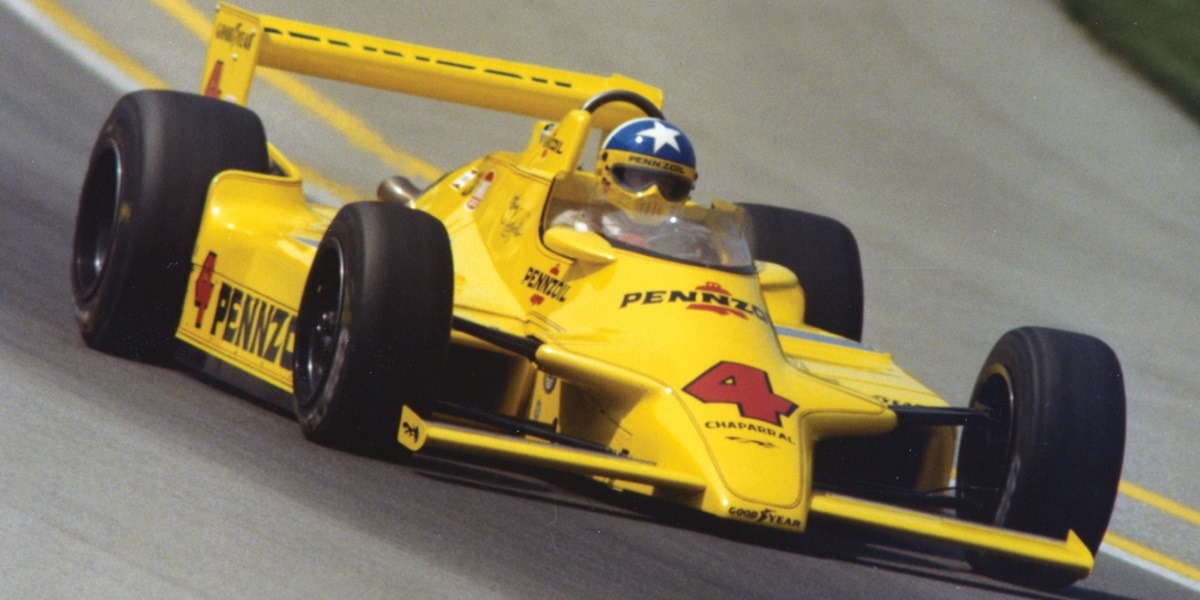
Rutherford, ‘Yellow Submarine’ Were Match Made in Horsepower Heaven
March 13, 2020 | By Paul Kelly, Indianapolis Motor Speedway
Every driver who wins the Indianapolis 500 earns a spot in the rich lore of motorsports and a piece of immortality. The same can’t always be said for the car that carried the driver to Victory Lane at the Indianapolis Motor Speedway.
But the 1980 Indianapolis 500 marked a rare convergence of a victory by a car that is just as legendary today as the man who drove it.
The “Yellow Submarine” and Johnny Rutherford.
That pairing of machine and man is one of the most fabled combinations in the history of “The Greatest Spectacle in Racing.” The “Yellow Submarine” and “Lone Star J.R.” are as synonymous as Ray Harroun and the Marmon “Wasp,” as Parnelli Jones and “Calhoun,” as Jim Clark and the Lotus, as Al Unser and the Johnny Lightning Special.
Rutherford is so associated with the car that some forget that he wasn’t the first driver to race it.
Four-time Indianapolis 500 winner Al Unser drove a Chaparral 2K designed by John Barnard and owned by Jim Hall during the 1979 season.
Unser showed the potential of the unique, ground-breaking car during the 1979 Indianapolis 500, when it also was painted in a yellow livery with Pennzoil sponsorship, just like Rutherford’s car in 1980. Big Al led 85 of the first 96 laps before an overheating gearbox ended his race in 22nd place after completing 104 laps.
Hall and Unser parted company after the 1979 season due to various disagreements, and Rutherford was named to the ride for 1980 because Team McLaren ended its participation in INDYCAR after the 1979 season. Many observers immediately pegged Rutherford as the driver to beat that season in the INDYCAR championship chase and at Indianapolis.
That assessment was spot-on.
Rutherford won the championship with five victories, including Indianapolis, with only Bobby Unser putting up a fight with Team Penske. The potential of the car in Rutherford’s hands at Indianapolis was proven April 13, 1980 when he won the Datsun Twin 200 at Ontario Motor Speedway, which had a 2.5-mile layout that was an exact clone of IMS.
At Indianapolis, “Lone Star J.R.” won the pole and beat Tom Sneva to the finish line in by 29.92 seconds. But Rutherford didn’t rule the race from start to finish like Clark and the Lotus in 1965, a pairing that led 190 of the 200 laps.
Still, Rutherford and the dominant Chaparral – nicknamed the “Yellow Submarine” due to its color, smooth, flowing design and low-slung chassis – ended up leading 118 laps. J.R. took the lead for good from Rick Mears on Lap 179 and cruised to victory.
One of the most memorable moments of Rutherford’s third run to Victory Lane at IMS happened after he took the checkered flag.
Rookie sensation Tim Richmond’s car ran out of fuel and stopped at the beginning of the front straightaway. Rutherford was finishing his victory cool-down lap, and he saw Richmond standing on the edge of the track.
Rutherford and the charismatic Richmond were in adjacent garages all month and became friendly. So J.R. motioned to Richmond to hitch a ride back toward the pits on his car, and Richmond laid on the sidepod of the “Yellow Submarine.”
The pair exchanged handshakes, and Richmond pointed to Rutherford as a mark of respect for his victory and his gesture. The fans went nuts, loving every second of it. Richmond hopped off the Chaparral 2K just before Rutherford entered Victory Lane to not distract from Rutherford’s victory celebration.
What made the “Yellow Submarine” so unique and beloved besides its livery and pure speed?
The Chaparral 2K was the first Indy car with “ground effects” designed into the chassis. This system of tunnels and ports on the bottom of the car, almost “sucked” the car to the surface of the track, creating incredible grip when the aerodynamics of the car pressed the car on the track.
Years later, Rutherford told noted motorsports writer Gordon Kirby that the 2K was the first car he ever drove that created enough g-forces in corners to cause him to grunt, almost like a football linebacker making a punishing tackle. That was about the only discomfort Rutherford experienced in 1980 with the remarkable, ground-breaking machine.
Ground effects weren’t new, as many cars by 1978 had rubber or plastic “skirts” attached to the sides of their chassis to generate suction and traction. Those skirts often created smoke due to friction when they touched the track, causing many observers to errantly think the car had an oil leak or engine problem.
But for the 1979 season, Barnard was the first designer to create a machine with this cutting-edge technology incorporated into the chassis, not bolted on. The technology revolutionized Indy-car design from there forward, also befuddling rival teams in 1979 and 1980.
Bobby Unser claimed he and mechanic/engineer Ronnie Dawes developed the ground effects for Penske Racing’s 1981 Indy 500-winning chassis after some unique espionage at the end of the 1980 season.
Rutherford was eliminated from the 1980 season finale, the Miller High Life 150 at Phoenix International Raceway, in a crash after completing 71 laps. The “Yellow Submarine” got upside down in the incident, and Unser learned that a fan took plenty of pictures of the bottom of the car immediately after the crash.
Unser reportedly tracked down the fan, got the photos, saw the complex series of tunnels and ports on the bottom of Rutherford’s car and used that as a baseline for development of Penske’s chassis for 1981.
If you can’t beat them, join them. That’s how dominant and revolutionary the “Yellow Submarine” was in 1980, securing its place in racing history and delivering Rutherford to a third, immortal victory at Indianapolis.